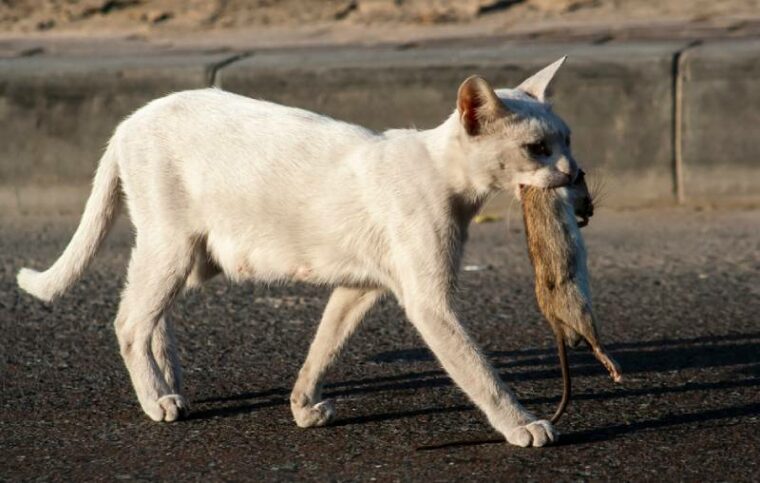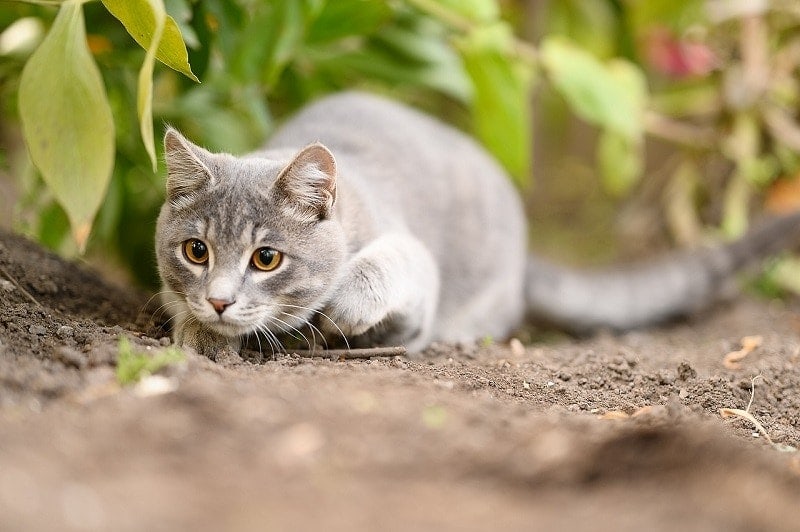
Cats are natural hunters that often bring their owners back presents of mice and other small critters if they’re allowed outside to hunt. But what about rats? The big rodents present a problem for cats; cats usually hunt much smaller prey, so they’re not that great at catching rats.
A study by Fordham University showed that cats weren’t actively hunting rats as much as previously thought and that the rats outsmarted them by moving to shelter as more cats entered the area.1
There were only three instances of cats actively hunting the 150 rats involved in the study, which used microchipped rats tracked with motion-sensing cameras. Moreover, the local cats managed to kill just two of these rats—preferring to hunt smaller, easier-to-kill prey instead.
Why Are Cats Bad at Killing Rats?
Rather than cats being bad at killing rats (cats are evolved to be highly efficient killing machines), it’s more that they don’t want to, probably because of the sheer size of the rodent.

The Size of Rats
Brown rats (Rattus Norvegicus), common in cities in the US, are immense; they often grow up to 20 inches long, weighing in at 1 to 2 pounds each. Even the smaller, less common black rat (Rattus Rattus) weighs close to 10 times that of their common mouse cousins (Mus Musculus), making them a much more intimidating prey to cats. Rats vastly outweigh cats in population, with one study putting the number of rats living in New York City at close to 2 million at any one time. In contrast, around 500,000 pet cats live in the city, with tens of thousands more thought to be part of feral populations.
The Defensive Capabilities of Rats
Rats of all species are well-equipped to defend themselves. They have strong, sharp teeth, razor-like claws, and a fierce will to live. For this reason, cats often choose to leave them alone. Even if a cat kills a rat, it could come away with some injuries. Feral cats, in particular, must think about the energy needed to stalk, catch, and kill their prey and the potential damage that prey could inflict. Rats might make a good meal that would keep them fed for a little while, but they are essentially less “cost-effective” to kill than smaller victims like mice.

Are Cats Good at Killing Other Animals?
To say cats are good at killing other animals is an understatement. Cats are prolific hunters; while they might not take on the mighty rats, cats are known to kill billions of small mammals and birds yearly in the US alone. A study by Nature detailed that cats kill 1.3–4.0 billion birds and 6.3–22.3 billion mammals annually in the US, a staggering number that contributes to decreasing populations of vulnerable species across the country. Cats are not only born to be great hunters, however. They’re also taught how to hunt by their mothers.
The effectiveness of hunting in cats can be determined by a few factors, including which prey animals are available and how many, the availability of other food sources, and environmental conditions. But the ability to locate, stalk, and kill prey is partially instinctual and taught by a mother cat to her kittens, which could be why some cats are much better at hunting than others. This also applies to rats; if a cat were raised being taught how to kill rats in the city effectively, they’d be more adept at hunting them than cats who’ve only had experience killing mice.
Are Cats Ever Used to Kill Rats?
Despite evidence to the contrary, some areas use cats to kill rats in urban places. For example, in Chicago, over 1,000 cats have been released into the city as part of the Cats at Work program, which uses cats that fail to integrate into homes or shelters as rodent deterrents outside populated buildings. Feral cats in Washington D.C. are also getting jobs, as cats are being placed at businesses and other areas with high rat populations as part of the Blue Collar Cat program.
While these programs might not be the most effective way of reducing rat populations in urban areas, they present a two-fold solution to the problem. First, cats that can’t integrate into traditional home settings but still need security, care, and a place to call home can find them in specially-made shelters once they get their jobs. Also, introducing a top-down solution (introducing a predator) is less dangerous than leaving out poisons such as warfarin, which can affect other wildlife in the areas.

Conclusion
While cats are known to be great at killing mice, rats aren’t usually on the menu. Rats in cities make a dangerous foe for domestic cats, and even feral cats have a hard time fighting the feisty rodents. Cats are great at hunting, but smaller prey like mice and birds are their favorite targets. However, many feral cats are being given a second chance by being hired by businesses and companies to live outside their buildings to catch and eat the rats.
Featured Image Credit: mshirani, Shutterstock






